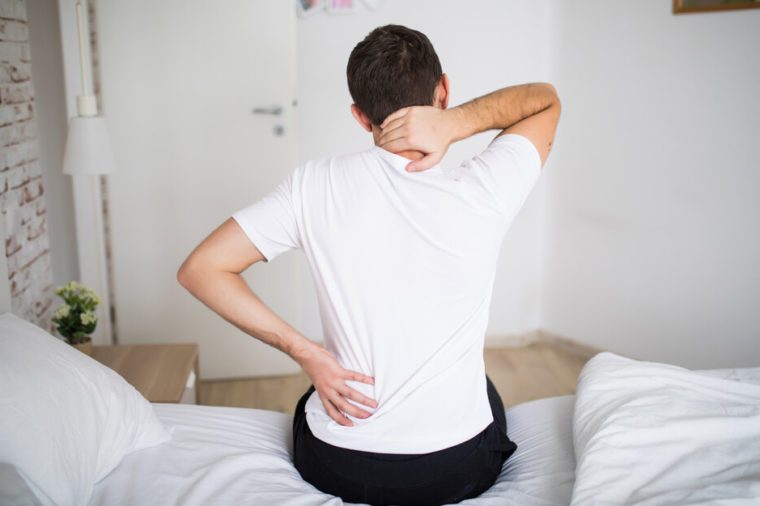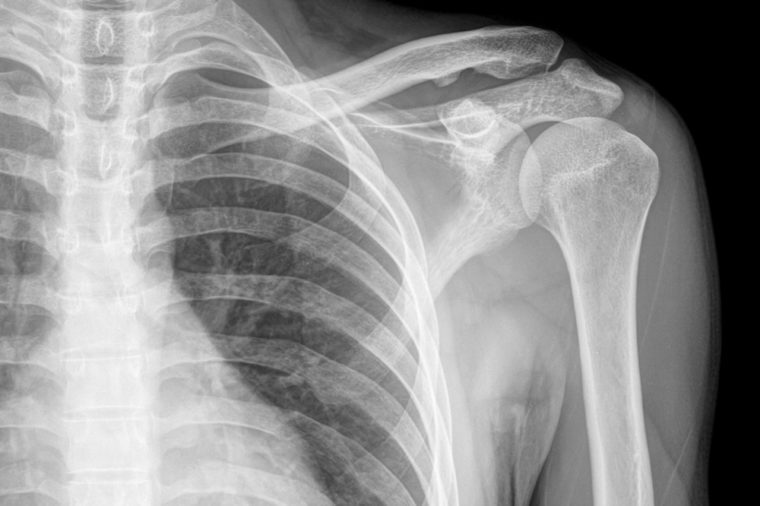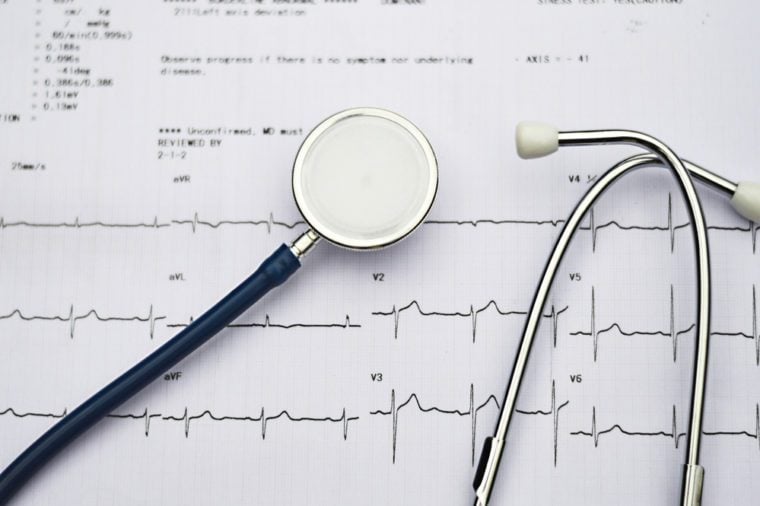
Poor posture
Your mom was right about standing up straight. Poor posture is one of the main causes of neck and shoulder blade pain, says Michael Schaefer, MD, a physiatrist with the Cleveland Clinic in Cleveland, OH. Your shoulders are designed to be rolled back, so they’ll start to get sore if you keep them hunched over all day. Breaking the habit can be tricky, but you can start to correct your posture without even trying. “Having a good setup where you’re working is the most important thing,” says Dr. Schaefer. Adjust your chair and keyboard so that your legs and arms are at a 90-degree angle, recommends Robert J. Meislin, MD, an orthopedic surgeon at New York University’s Langone’s Sports Medicine Center in New York, NY.
To keep your muscles and joints healthy, make sure to follow these pain management tips from Canadian physiotherapists.

Long periods sitting
Even with decent posture, staying in the same position for hours on end can take its toll and lead to shoulder blade pain. Dr. Meislin recommends shifting positions or stretching every 20 minutes—set a timer if you need the reminder. Investing in an adjustable desk that lets you switch between standing and sitting makes it easy to move without interrupting your workday. If you need to make phone calls often, use a headset instead of cradling the phone against your shoulder.
Check out these tips for relieving back pain.

Front-focused workouts
“When patients work out in the gym, they’re pretty much looking at the front of the bodies in the mirrors and not the back,” says Dr. Meislin. “Nobody is spending enough time on those scapula muscles.” When the chest muscles are way more developed than the back muscles, the shoulder blades can get pulled forward, messing up your posture. Strengthening your back will encourage your shoulders to correct themselves, so add some targeted moves into your routine. Your best bet is to enlist a physical therapist, Dr. Meislin says, but there are some moves that can get you started. Lie belly-down on a bench to do dumbbell rows, or arch your back “like a cat purring” while doing push-ups to engage those muscles, he suggests.
Here are the best workouts for people who hate exercise.

Lifting heavy objects
Pay attention to your posture when you’re lifting heavy objects. Lifting with your shoulders or keeping them arched too high could overexert the muscles and lead to shoulder blade pain. You may have heard to lift with your legs and not your back, but you shouldn’t ignore your torso, either. “You want to squat down and engage your core, lifting with your abdominal diaphragm as well,” says Dr. Meislin.

Shingles
Triggered by the same virus that causes chicken pox, shingles is best known for the painful rash it causes. But even before you notice any redness or bumps, you might feel tingling or burning pain—often on the front of the torso but sometimes on a shoulder blade. “It’s usually quickly followed by the rash, so that confirms the diagnosis,” says Dr. Schaefer, “but for the first two or three days, it can present just as pain.”
Think twice about believing these myths about skin tags.

Intercostal neuralgia
When the nerves on the spinal cord below the ribs are irritated or inflamed, the aggravation causes shooting pain in the chest and upper back from a disorder called intercostal neuralgia. In some cases, that pain can also radiate to the shoulder blades, says Dr. Schaefer. Talk to your doctor, who can recommend over-the-counter treatments or prescription medication that eases the shoulder blade pain.
Talk to your doctor if you experience any of these serious health symptoms.

Herniated disc
When the soft inner core of a spinal disc pushes out, it becomes “herniated” and can irritate the nearby joints. That pain can refer to the shoulder blades if the herniated disc is in the cervical (neck) spine, or particularly the thoracic (upper- and midback) spine, says Dr. Meislin. “As you descend down the thoracic or midback, it’s referring over to the scapula area,” he says. In many cases, over-the-counter painkillers will be enough to ease the pain.
Check out more herniated disc signs you might be ignoring.

Winged scapula
Normally, the shoulder blades lie flat, but they sometimes stick out in a condition known as scapular winging. “The scapula doesn’t protract or go in a forward motion,” says Dr. Meislin. “It just retracts.” The condition is caused by nerve damage in the shoulders, neck, and arms as a result of an injury, surgery complications, or a medical condition. Talk to your doctor; the winged scapula can sometimes heal on its own with the help of physical therapy, but other times it might require surgery.
These groundbreaking health studies will change the way you live.

Osteoporosis
The weakened bones of osteoporosis won’t directly cause shoulder blade pain, but it might eventually become a side effect. If a bone in the spine breaks from the brittleness, the back could begin to curve forward. “Indirectly, it can contribute to that hunched-forward posture,” says Dr. Schaefer. As discussed earlier, poor posture can be bad news for your shoulder blades, so it’s particularly important to focus on proper alignment if you have osteoporosis.
Banish these lifestyle factors that increase your risk of osteoporosis.

Fibromyalgia
It’s unclear what causes the widespread pain of fibromyalgia, but researchers think it has to do with the brain’s pain signals. The brain thinks there’s pain without a trigger and overreacts when there really is something painful to respond to. “Generalized fibromyalgia [has] multiple trigger-point symptoms that could rear its ugly head in the scapula area,” says Dr. Meislin. Other particularly painful spots could include the neck, elbows, hips, and knees.

Lung cancer
You might associate the lungs with the chest, but that pain can also refer back to the shoulder blades. Doctors aren’t sure why the pain gets referred somewhere else, but they think it has to do with a miscommunication. “The brain doesn’t usually perceive things like the internal organs on a regular basis, so when it gets a foreign or unusual pain stimulus from an internal organ, it probably causes confusion—like short-circuiting,” says Dr. Schaefer. In some cases, that means the brain sends pain signals to the shoulders. It’s not common for lung cancer and other pulmonary issues to cause shoulder blade pain, but if you’ve also been experiencing symptoms like coughing, wheezing, or weight loss, your doctor will probably investigate further. Other causes of referred shoulder pain include a gallbladder attack, ruptured appendix, and ruptured ectopic pregnancy.
Learn to spot these other signs of lung cancer.

Heart problems
In rare cases, cardiovascular issues like heart attacks or a torn aorta could also radiate back to the shoulder blades. Most people with upper-back pain shouldn’t worry about a cardiac emergency, but your doctor might do tests if you have risk factors like a history of smoking or high cholesterol. “In someone with risk factors … [shoulder blade pain] usually becomes a bit more concerning, especially when you can’t find any more reason for it and an examination doesn’t show tenderness or swelling,” says Dr. Schaefer. Women are more likely to experience heart attack pain in places other than the chest, so call the doctor immediately if it’s paired with other concerning symptoms such as shortness of breath or nausea.
Next, check out the true story of how this teacher’s back pain turned out to be a life-threatening condition.